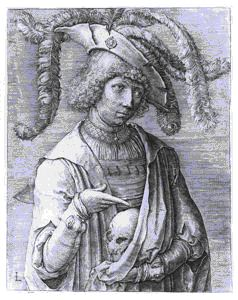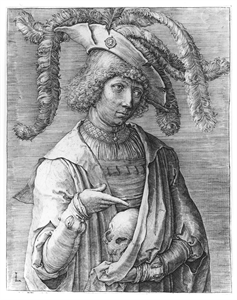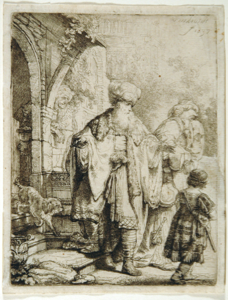
Lucas van Leyden (aka Lucan Van Leyden)
Dutch, about 1489/1494–1533
Lucas van Leyden’s composition “Portrait of a Young Man with a Skull” has long been considered a self-portrait. Although there is no conclusive evidence to determine such, in 1604 biographer Karl van Mander wrote, “Lucas was on the short side and rather slight, there is a portrait of him engraved by himself, young and beardless, a bit more than half-length, wearing a large feathered cap and holding a skull to his breast inside his mantle.” This work, like many others produced by van Leyden in 1519, focuses on the specific theme of vanitas or the fleeting pleasures of the world. In this case, the artist addresses the theme in terms of a moral allegory. The skull held to the young man’s abdomen is a "memento mori" or reminder of death. The partially concealed skull, paired with the elegant costume and extravagant plumed hat worn by the subject, serves as an admonition to viewers to beware the frivolous pleasures of life and ephemeral nature of youthful beauty.
Dutch, about 1489/1494–1533
Portrait of a Young Man with a Skull
about 1519
Object Type:
Print
Creation Place:
Northern Europe, Dutch
Dimensions:
7 1/4 in. x 5 3/4 in. (18.42 cm x 14.61 cm)
Medium and Support:
Engraving on paper
Accession Number:
1999.0007.0040
Credit Line:
Gift of Jean K. Weil in memory of Adolph "Bucks" Weil, Jr.
Lucas van Leyden’s composition “Portrait of a Young Man with a Skull” has long been considered a self-portrait. Although there is no conclusive evidence to determine such, in 1604 biographer Karl van Mander wrote, “Lucas was on the short side and rather slight, there is a portrait of him engraved by himself, young and beardless, a bit more than half-length, wearing a large feathered cap and holding a skull to his breast inside his mantle.” This work, like many others produced by van Leyden in 1519, focuses on the specific theme of vanitas or the fleeting pleasures of the world. In this case, the artist addresses the theme in terms of a moral allegory. The skull held to the young man’s abdomen is a "memento mori" or reminder of death. The partially concealed skull, paired with the elegant costume and extravagant plumed hat worn by the subject, serves as an admonition to viewers to beware the frivolous pleasures of life and ephemeral nature of youthful beauty.
Keywords
Click a term to view the records with the same keyword
Additional Images
Click an image to view a larger version
Portfolio List
Click a portfolio name to view all the objects in that portfolio
This object is a member of the following portfolios:
Your current search criteria is: Portfolio is "Highlights: Weil Gifts".

 by Artist (36)
by Artist (36)


